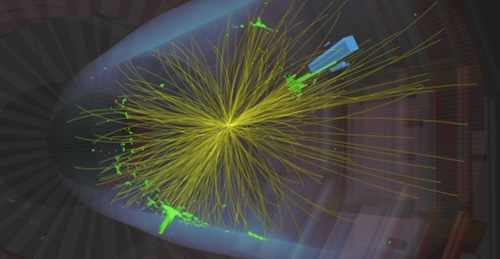Searching for Dark Matter Variants of Quarks and Gluons
Scientists look for tiny deviations between the precise experimental measurements made in particle colliders and the predictions from the standard model to search for signs of any new physics. The events—the products from proton collisions—used for such comparisons are usually particle jets, which are discrete clusters of highly energetic particles that stream together in various directions. However, new physics could also show up in spherically uniform distributions of low-energy particles called soft unclustered energy patterns (SUEPs). Now scientists from the CMS Collaboration at the Large Hadron Collider (LHC) have conducted the first search for SUEPs [1]. It came up empty.
SUEPs are predicted by certain hypothetical extensions of the standard model known as hidden valley models. The theories feature as-yet unobserved dark matter particles that are reminiscent of the standard model’s quarks and gluons. Particle collisions could occasionally produce such dark matter particles. Whereas the standard-model quarks lose energy by radiating other particles packed tightly within jets, these dark matter variants can radiate many low-energy dark matter daughter particles uniformly in all directions. Some of these dark matter daughter particles might decay back into standard-model particles that the CMS detector could conceivably detect as SUEPs.
The CMS team selected the events that were spherical. Their measured number did not exceed the standard-model prediction, allowing the team to place limits on the masses of the dark matter particles and other parameters within hidden valley models for the first time. CMS scientists say that a more precise search for SUEPs is already underway using additional data from ongoing collisions at the LHC.
–Nikhil Karthik
Nikhil Karthik is an Associate Editor for Physical Review Letters.
References
- 1. A. Hayrapetyan et al. (CMS Collaboration), “Search for soft unclustered energy patterns in proton-proton collisions at 13 TeV,” Phys. Rev. Lett. 133, 191902 (2024).




